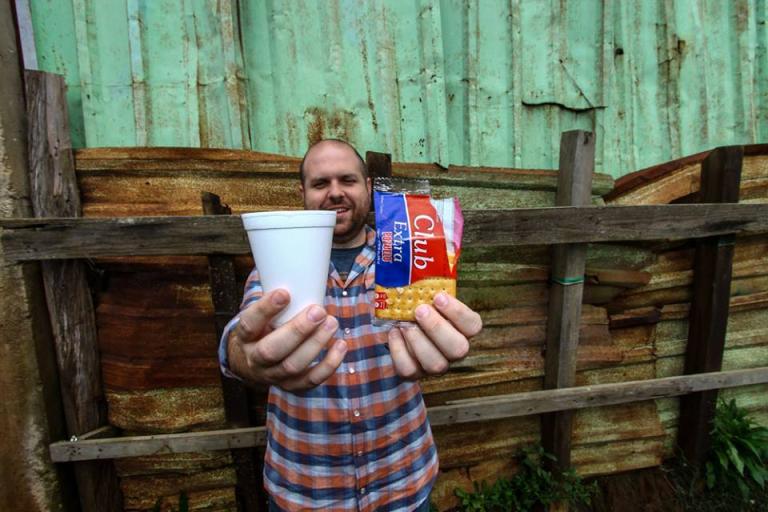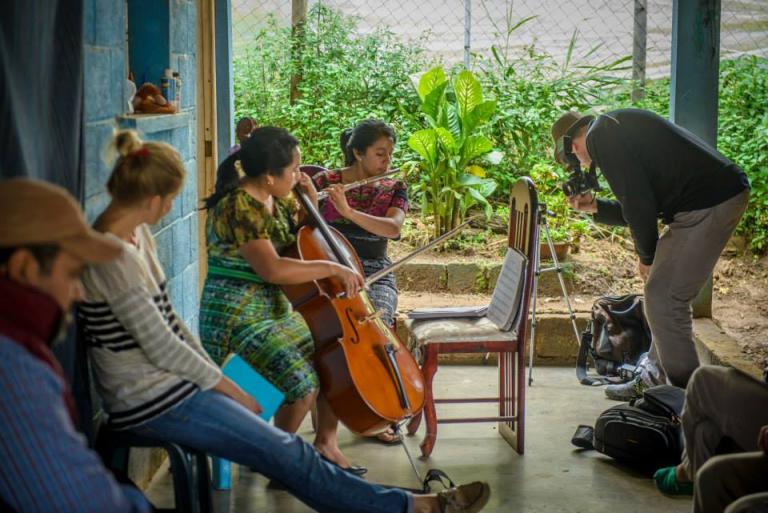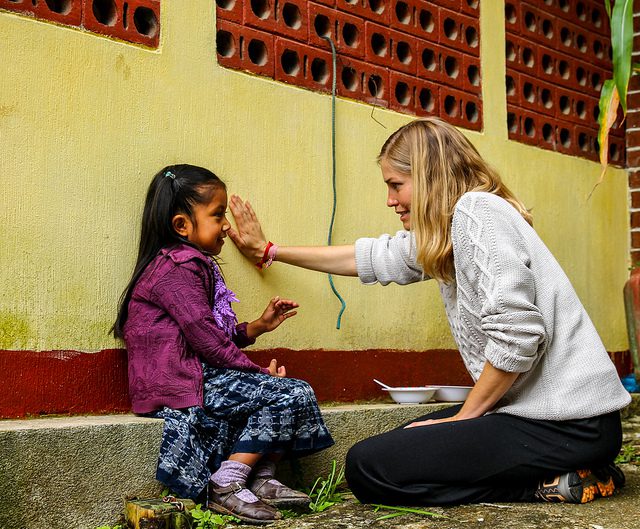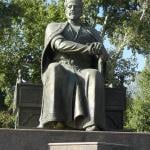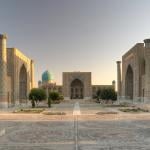On our last day in Guatemala, we return to the community where we spent most of the week. We pull up along a rocky dirt road, where the nearest restroom is a up the hill in a little abuela’s house. We walk down the path to an old, dilapidated former-carpentry school, where children are arriving for music practice.
Every Saturday all the kids in the music program gather here at their community’s World Vision music school. They meet in the blue cinder block classrooms, where some of the floors are covered with water from the daily downpours of the rainy season. We walk past a few windows where shreds of glass jut out from the frames and into the space between classrooms. Two tuba players stand in a field, wild grass growing up to their knees, music stands in front of them, their instructor counting out the rhythm. We step over the open gutter systems that run along the ground.
On every sidewalk, groups of two or three music students are running through scales. It sounds like any other school of music. It’s just that this one is mostly outside and most of the students here have walked miles and miles with their instruments strapped to their backs to get here. In another room in the complex, a group of mothers and babies are finishing a music class taught by volunteers. Their class looks just like the one I took August to when he was 15 months old. They clap their children’s hands and dance with them to a song while a 20 year old volunteer teacher plays a song on her violin. Another girl walks around the circle singing with a puppet in her hands.
In another room, twenty children ages 5 to 12 years old play in unison on their violins, some with meticulous finger work. They play staccato notes from memory, then move their bows into long, full whole notes. Their movement around their violins speaks to hours of practice. I go from hearing “Twinkle Twinkle” in one room, to full and beautiful classical pieces from the official orchestra as it rehearses. The Saturday music school is a volunteer-run program. The teachers don’t get paid, and some who lead the younger violinists or brass players, also play in the official orchestra. Every one here is playing because they love playing.
I learn the story of Hector, a 19 year old cellist, who recently earned a seat in the Guatemalan Symphonic Orchestra. He explains to us how he will have this position for life and will always be able to care for his family. His story is the sweetest kind of story from this trip. It’s the story of a child in need who was given a chance to move past his “fate” in poverty. A child whose potential would have been untapped if World Vision had not stepped in.
Hector’s story is like Alma’s story. Alma works as World Vision’s Guatemalan Sponsorship Coordinator. She was a sponsored child when World Vision first arrived in Guatemala in the 80’s. When she eats dinner with us and shares what her sponsor meant to her and the opportunities that sponsorship gave her, we see in her a message of possibility. Her life tells the story of a woman born into poverty who was given the opportunity to emerge from its control. Her children, she tells us, will never need a sponsor. They have broken free of the cycle of poverty. And she knows it’s possible. It’s possible for the children World Vision serves.
*
And in every place, among each story, I’m reminded that this work of reaching into poverty and offering hope is a complicated thing. What is the role of the church? What is the responsibility of someone like me, a white, upper middle class woman who lives a completely separate life in the United States? What is God giving me the opportunity to do? Where is God at work? What is best for the children of Guatemala?
In the area we visited, I saw so many things I loved: Every aspect of World Vision’s work was run by Guatemalans. I did not see one North American in the field. This is what mission work should look like everywhere. It was beautiful and holistic. I was moved and impressed by the Guide Mother program and the wisdom of mothers being trained and equipped to help other mothers in her community. I saw a program of nutritional education that is really working to eradicate childhood malnutrition.
We didn’t get a chance to see other areas of Guatemala, areas where the work is younger, where the Guide Mother program is just beginning, where children are still ninety percent malnourished, instead of three percent, as in the area we saw. I would love to be able to tell you what that looks like. I wish I could point to the need in those areas.
World Vision tries to spend around 12 to 15 years in a community, working to create a community renewal that is self-sustaining. Then, when the people are prepared and equipped, World Vision leaves the work in the hands of the people of that community. I believe in that system and I sensed that in the community we visited, the people were near-ready. Their community seemed equipped and ready to move forward. That is hope-filled. That’s a beautiful thing.
There is a lot for me to process still. There are questions I’m working through about the need for a music program in a impoverished place. What role should the arts play in a humanitarian organization? Where should we focus our giving when there is so much basic need? Honestly, I don’t know. How do we choose what we give our money to? To music? To nutrition? To sponsorship?
*
Humanitarian work is a complicated thing. But I will tell you this, when Micah 6:8 instructs the people of Israel in God’s desire for their lives, it is a calling to: “Live justly, to love mercy, and to walk humbly with [their] God.” Sometimes learning to live justly and love mercy begins with humility. Sometimes humility looks like asking all the questions. But sometimes, that same humility leads you to give with hope and expectation, even when every question isn’t quite resolved.
It is important and sacred when a child is told she is valuable. It is a good and right and holy thing when a child is given food that allows his body to grow strong and his brain to hold information. And you know what else is beautiful? A child like Hector learning to make holy sounds with a cello in a one-room cinder block house.
I want to offer you these stories and I want you hear my heart: This matters. And World Vision is doing something valuable and vital. I still want to know more. I still want to process more of what I saw. But, as I do, if you feel drawn to sponsor a child with me in Guatemala, I hope you will.
Photo Credit: Matthew Paul Turner



